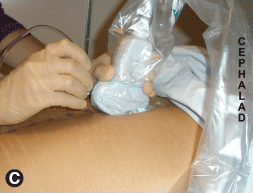Mark a 2.5 cm point lateral to each spinous process.
Approach and Technique
 Out-of-plane needle guidance: Apply transducer perpendicular to skin in a parasagittal plane 2 cm lateral to the midline and parallel to the spine. Insert the block needle perpendicular to the skin after injecting a local anesthetic skin wheal and advance the needle out-of-plane toward the paravertebral space.
Out-of-plane needle guidance: Apply transducer perpendicular to skin in a parasagittal plane 2 cm lateral to the midline and parallel to the spine. Insert the block needle perpendicular to the skin after injecting a local anesthetic skin wheal and advance the needle out-of-plane toward the paravertebral space.
When the needle tip passes the superior costotransverse ligament (thoracic) or the desired depth is achieved (~ 1 cm past the transverse process for thoracic; 0.5 cm past the transverse process for lumbar), inject 5 mL of local anesthetic solution after negative aspiration for blood. Repeat process for each level.

A. When performing out-of-plane thoracic paravertebral block, identify the spinous processes of the vertebrae representing the desired dermatomal levels of anesthesia. Approximate sites for needle insertion are then marked 2.5 cm lateral to each spinous process over the transverse process of the vertebra one level caudad. B. Transducer positioning and needle insertion technique during out-of-plane ultrasound-guided paravertebral block.
 In-plane needle guidance: Apply the transducer perpendicular to the skin in a parasagittal plane 2 cm lateral to the midline and parallel to the spine.
In-plane needle guidance: Apply the transducer perpendicular to the skin in a parasagittal plane 2 cm lateral to the midline and parallel to the spine.
US-GUIDED PARAVERTEBRAL BLOCK

Stay updated, free articles. Join our Telegram channel

Full access? Get Clinical Tree







